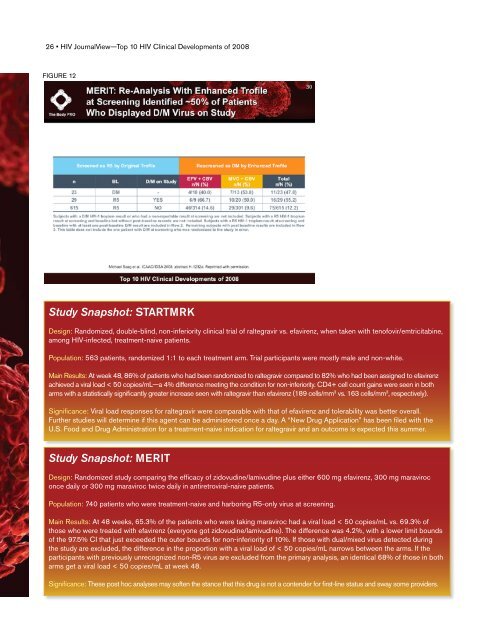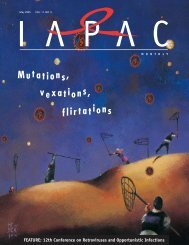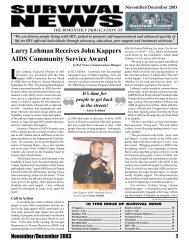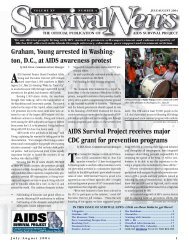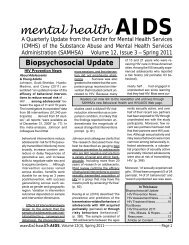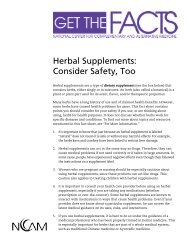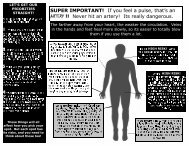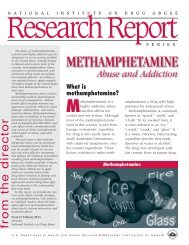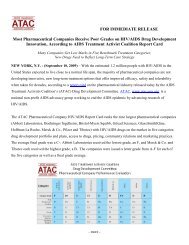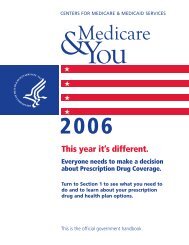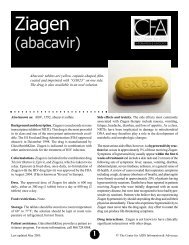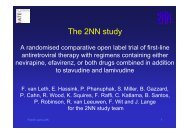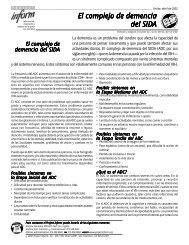Top 10 HIV Clinical Developments of 2008 - CD8 T cells - The Body
Top 10 HIV Clinical Developments of 2008 - CD8 T cells - The Body
Top 10 HIV Clinical Developments of 2008 - CD8 T cells - The Body
Create successful ePaper yourself
Turn your PDF publications into a flip-book with our unique Google optimized e-Paper software.
26 • <strong>HIV</strong> JournalView—<strong>Top</strong> <strong>10</strong> <strong>HIV</strong> <strong>Clinical</strong> <strong>Developments</strong> <strong>of</strong> <strong>2008</strong><br />
FIGURE 12<br />
Study Snapshot: STARTMRK<br />
Design: Randomized, double-blind, non-inferiority clinical trial <strong>of</strong> raltegravir vs. efavirenz, when taken with ten<strong>of</strong>ovir/emtricitabine,<br />
among <strong>HIV</strong>-infected, treatment-naive patients.<br />
Population: 563 patients, randomized 1:1 to each treatment arm. Trial participants were mostly male and non-white.<br />
Main Results: At week 48, 86% <strong>of</strong> patients who had been randomized to raltegravir compared to 82% who had been assigned to efavirenz<br />
achieved a viral load < 50 copies/mL—a 4% difference meeting the condition for non-inferiority. CD4+ cell count gains were seen in both<br />
arms with a statistically significantly greater increase seen with raltegravir than efavirenz (189 <strong>cells</strong>/mm 3 vs. 163 <strong>cells</strong>/mm 3 , respectively).<br />
Significance: Viral load responses for raltegravir were comparable with that <strong>of</strong> efavirenz and tolerability was better overall.<br />
Further studies will determine if this agent can be administered once a day. A “New Drug Application” has been filed with the<br />
U.S. Food and Drug Administration for a treatment-naive indication for raltegravir and an outcome is expected this summer.<br />
Study Snapshot: MERIT<br />
Design: Randomized study comparing the efficacy <strong>of</strong> zidovudine/lamivudine plus either 600 mg efavirenz, 300 mg maraviroc<br />
once daily or 300 mg maraviroc twice daily in antiretroviral-naive patients.<br />
Population: 740 patients who were treatment-naive and harboring R5-only virus at screening.<br />
Main Results: At 48 weeks, 65.3% <strong>of</strong> the patients who were taking maraviroc had a viral load < 50 copies/mL vs. 69.3% <strong>of</strong><br />
those who were treated with efavirenz (everyone got zidovudine/lamivudine). <strong>The</strong> difference was 4.2%, with a lower limit bounds<br />
<strong>of</strong> the 97.5% CI that just exceeded the outer bounds for non-inferiority <strong>of</strong> <strong>10</strong>%. If those with dual/mixed virus detected during<br />
the study are excluded, the difference in the proportion with a viral load <strong>of</strong> < 50 copies/mL narrows between the arms. If the<br />
participants with previously unrecognized non-R5 virus are excluded from the primary analysis, an identical 68% <strong>of</strong> those in both<br />
arms get a viral load < 50 copies/mL at week 48.<br />
Significance: <strong>The</strong>se post hoc analyses may s<strong>of</strong>ten the stance that this drug is not a contender for first-line status and sway some providers.


